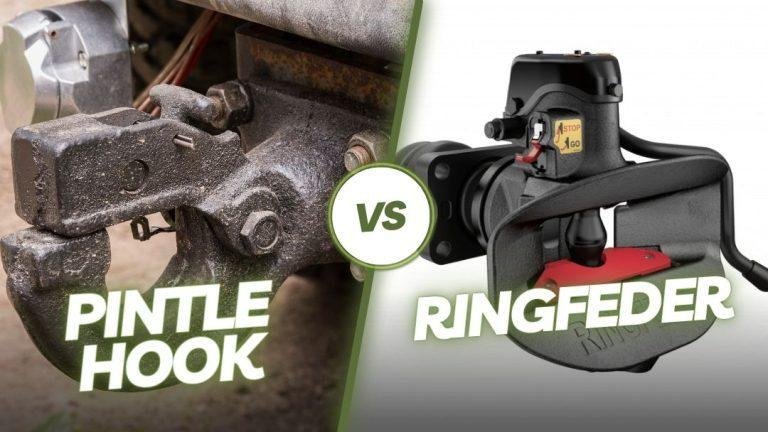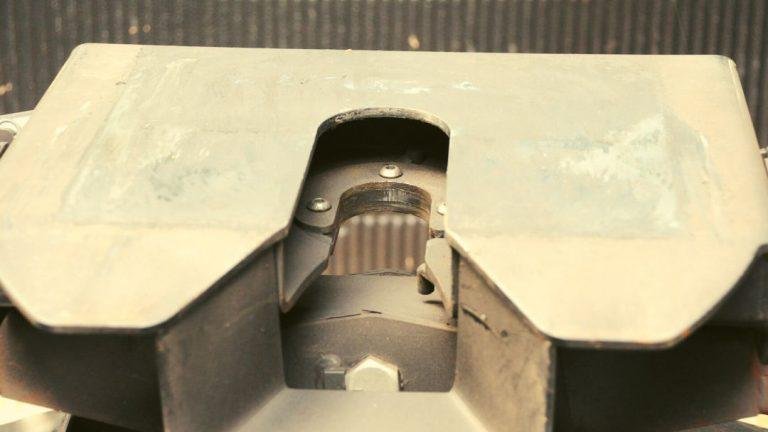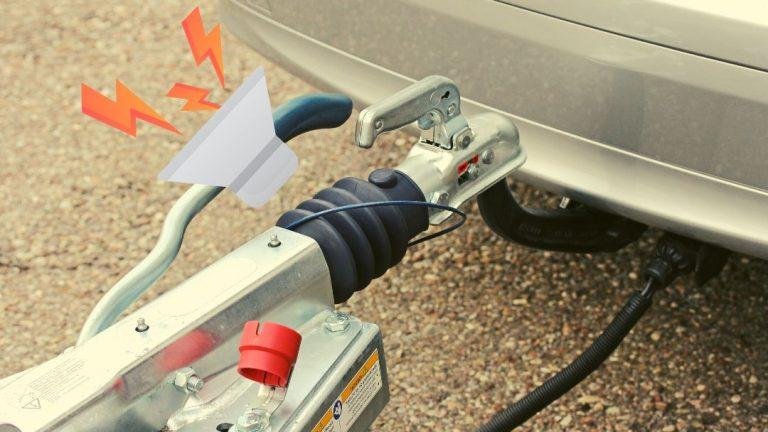A fifth wheel hitch works by securely connecting a trailer to a towing vehicle, providing stability and allowing for easier maneuverability. This type of hitch is designed with a kingpin and a hitch plate that fit together, creating a strong connection point between the trailer and the towing vehicle.
The hitch is typically mounted in the truck bed, directly above the rear axle, providing a balanced weight distribution and reducing swaying while towing. Once connected, the fifth wheel hitch allows the trailer to move independently from the towing vehicle, making it ideal for carrying heavy loads and maneuvering tight turns.
So whether you are a seasoned trailer owner or new to towing, understanding how a fifth wheel hitch works is essential for a safe and efficient towing experience.
Understanding The Basics Of A Fifth Wheel Hitch
A fifth wheel hitch is an essential component in towing trailers. It works by attaching to a truck bed, providing stability and support during transportation. Understanding how it functions can help ensure a safe and efficient towing experience.
Fifth wheel hitches are essential components of towing setups for heavy-duty trailers, providing stability and maneuverability on the road. In this section, we will delve into the definition, purpose, components, and benefits of using a fifth wheel hitch. So, let’s explore the fundamentals of this crucial towing mechanism.
Definition And Purpose Of A Fifth Wheel Hitch:
- A fifth wheel hitch is a specialized device that facilitates the connection between a towing vehicle and a fifth wheel trailer.
- It is commonly used in heavy-duty towing scenarios, such as hauling large recreational vehicles (rvs) or industrial equipment.
- The primary purpose of a fifth wheel hitch is to distribute the weight of the trailer evenly between the truck and trailer’s axles, enhancing stability and towing efficiency.
- By design, a fifth wheel hitch offers superior maneuverability compared to traditional ball hitches, making it an ideal choice for tight turns and difficult terrains.
Components Of A Fifth Wheel Hitch:
A fifth wheel hitch consists of several key components that work together harmoniously to ensure a secure connection and smooth towing experience. These components include:
- Coupler: The coupler forms the connection point between the trailer and the fifth wheel hitch. It typically consists of a pivoting plate that attaches to the kingpin of the trailer.
- Kingpin: The kingpin is a vertical pin located on the front of the trailer’s chassis. It fits into the coupler and enables the trailer to pivot smoothly during turns.
- Locking mechanism: The locking mechanism secures the coupler to the kingpin, preventing accidental disconnection while towing. It ensures a reliable and stable hitch connection throughout the journey.
- Mounting rails: Mounting rails provide a sturdy foundation for the fifth wheel hitch on the bed of the towing vehicle. Proper installation of these rails is crucial to ensure optimal weight distribution and hitch performance.
Benefits Of Using A Fifth Wheel Hitch:
- Enhanced stability: The design and configuration of a fifth wheel hitch provide exceptional stability during towing, minimizing swaying and improving overall control.
- Increased towing capacity: Fifth wheel hitches have a higher weight-carrying capacity compared to conventional ball hitches. This allows for towing heavier trailers and payloads.
- Improved maneuverability: Due to its placement over the rear axle of the towing vehicle, a fifth wheel hitch facilitates sharper turns and smoother navigation, especially in tight spaces or challenging terrains.
- Better weight distribution: The unique geometry of a fifth wheel hitch ensures the weight of the trailer is distributed evenly between the truck and trailer axles. This results in better balance and improved handling during towing.
Now that we have explored the basics of a fifth wheel hitch, you will have a better understanding of its purpose, components, and the benefits it offers. With proper knowledge and installation, a fifth wheel hitch can significantly enhance your towing experience, providing stability, maneuverability, and peace of mind on the road.
Types Of Fifth Wheel Hitches
Fifth wheel hitches come in different types, including fixed and sliding hitches, to accommodate various towing needs. These hitches work by attaching to the tow vehicle’s bed and providing a secure connection between the trailer and the vehicle, allowing for safe and smooth towing.
A variety of fifth wheel hitches are available to meet the specific towing needs of different vehicles and towing situations. In this section, we will explore the types of fifth wheel hitches commonly used and their features, benefits, suitable vehicles, and the pros and cons of each type.
Fixed Fifth Wheel Hitches
- Fixed fifth wheel hitches are the most basic and common type of fifth wheel hitch.
- Designed to be permanently fixed to the bed of the truck, these hitches offer a sturdy and secure connection between the truck and the trailer.
- They provide stability and reliability during towing, making them ideal for heavy-duty towing and frequent towing needs.
- Suitable for vehicles used primarily for towing fifth wheel trailers and not requiring the flexibility to disconnect the hitch when not in use.
- Some features and benefits of fixed fifth wheel hitches include:
- Can handle higher weight capacities compared to other types of hitches.
- Easy to install and use.
- Low maintenance requirements.
- Provides a solid and stable towing experience.
Sliding Fifth Wheel Hitches
- Sliding fifth wheel hitches are designed to offer flexibility and maneuverability when towing with a short-bed truck.
- They have a sliding mechanism that allows the hitch to move back and forth in the truck bed, ensuring proper clearance between the cab and the trailer during turns or tight maneuvers.
- Suitable for vehicles with short-bed trucks where additional clearance is required to prevent the trailer from hitting the cab.
- Some features and benefits of sliding fifth wheel hitches include:
- Provides added maneuverability and clearance when towing with a short-bed truck.
- Allows for better control and stability during turns and tight situations.
- Can be locked in different positions based on the towing needs.
- Easy installation and operation.
Automatic Sliding Fifth Wheel Hitches
- Automatic sliding fifth wheel hitches combine the features of fixed and sliding fifth wheel hitches.
- These hitches automatically move the hitch head back and forth based on the truck’s turning angle, providing the necessary clearance without requiring manual adjustments.
- Suitable for vehicles with short-bed trucks where convenience and ease of use are a priority.
- Some features and benefits of automatic sliding fifth wheel hitches include:
- Offers the convenience of automatically adjusting the hitch position.
- Provides optimal clearance without the need for manual adjustments.
- Ensures smooth and safe towing experience.
- Compatible with different towing situations and trailer sizes.
Overall, the choice of fifth wheel hitch depends on the specific towing needs, vehicle type, and preferences. Evaluating the features, benefits, suitable vehicles, as well as the pros and cons of each type, will help you make an informed decision for a smooth and secure towing experience.
How To Properly Install A Fifth Wheel Hitch
Installing a fifth wheel hitch requires careful steps to ensure proper function. Learn how this type of hitch works and follow the guidelines for a successful installation.
Choosing The Right Fifth Wheel Hitch For Your Vehicle
- Weight capacity: Consider the weight of your trailer and choose a hitch with a weight capacity that exceeds it.
- Hitch type: There are three common types: fixed hitch, sliding hitch, and pivoting hitch. Choose the one that suits your needs.
- Compatibility: Ensure that the hitch is compatible with your vehicle’s towing system and mounting rails.
Determining The Correct Placement Of Mounting Rails
- Bed length: Determine the length of your truck bed and choose the appropriate mounting rail kit.
- Clearance: Measure the distance between the truck cab and the trailer when making sharp turns to ensure there’s enough clearance.
- Positioning: Place the mounting rails at the precise location on the truck bed, based on the hitch manufacturer’s instructions.
Step-By-Step Installation Process
- Preparing the vehicle for installation:
- Clean the truck bed thoroughly, removing any debris or dirt.
- Ensure the truck bed is completely empty to provide ample space for installation.
- Installing mounting rails:
- Position the mounting rails on the truck bed in accordance with the hitch manufacturer’s instructions.
- Secure the rails using the provided hardware, ensuring they are tightly fastened.
- Attaching the hitch assembly:
- Lift the hitch into place, aligning it with the mounting rails and ensuring it is level.
- Attach the hitch to the mounting rails using the provided bolts, washers, and nuts. Tighten them securely.
Safety Considerations During Installation
- Use proper lifting techniques or seek assistance to avoid strain or injury when lifting the hitch assembly.
- Follow all safety precautions and guidelines provided by the hitch manufacturer.
- Double-check the tightness of all bolts and connections to ensure stability before towing your trailer.
By following these step-by-step instructions and safety considerations, you can properly install a fifth wheel hitch on your vehicle. Remember to choose the right hitch, determine the correct placement of mounting rails, and follow the installation process meticulously. This will ensure a safe and secure towing experience while adding efficiency to your travels.
Tips For Safe And Efficient Towing With A Fifth Wheel Hitch
Get expert tips for towing safely and efficiently with a fifth wheel hitch. Discover how this type of hitch works and ensure a smooth towing experience.
Proper weight distribution and load balance:
- Ensure that the weight of your trailer is evenly distributed to prevent any issues during towing.
- Pay attention to the recommended weight limits for your specific fifth wheel hitch.
- Distribute the load in a way that ensures stability and maintains a balanced center of gravity.
Adjusting the hitch height and angle:
- Adjust the hitch height according to the height of your towing vehicle to achieve a level ride.
- Make sure the hitch is securely attached and at the proper angle to maintain stability during towing.
Securing the load and performing regular maintenance:
- Double-check all connections and make sure everything is secure before hitting the road.
- Perform regular maintenance on your fifth wheel hitch, including lubrication and inspection of all components.
- Check the tires, brakes, and other crucial parts of your trailer before each trip.
Maneuvering and turning techniques:
- Take wider turns when towing with a fifth wheel hitch to avoid hitting curbs or other obstacles.
- Be mindful of your trailer’s turning radius and make adjustments accordingly.
- Practice maneuvering in an open space before navigating through tight spots or congested areas.
Recommended speed and driving practices:
- Adhere to the recommended speed limits and adjust your speed according to road conditions.
- Maintain a safe distance from other vehicles and anticipate any sudden stops ahead.
- Avoid aggressive acceleration or braking to prevent undue stress on your fifth wheel hitch.
Essential safety tips for towing with a fifth wheel hitch:
- Always check your mirrors and maintain proper visibility of the road and surrounding vehicles.
- Use your trailer brakes when necessary and leverage your towing vehicle’s braking system effectively.
- Be mindful of your trailer’s height and clearance to avoid low bridges or overhangs.
Remember, safe and efficient towing with a fifth wheel hitch depends on proper weight distribution, regular maintenance, and adopting appropriate driving techniques. By following these tips, you can enjoy a smoother and more reliable towing experience.
Frequently Asked Questions For How Fifth Wheel Hitch Works
What Is One Disadvantage Of The Fifth Wheel Hitch?
One disadvantage of the fifth wheel hitch is limited bed space. The hitch takes up a significant portion of the truck bed, reducing available cargo space. This can be problematic for those needing to transport larger items or equipment. Additionally, the hitch’s location may hinder access to the truck bed itself, making it more difficult to load and unload items.
Another drawback is the overall length of the vehicle when towing with a fifth wheel hitch. Maneuvering in tight spaces or parking can become more challenging due to the extended length. Despite these downsides, the fifth wheel hitch offers many advantages, such as increased stability and weight capacity, making it a popular choice for towing heavy loads.
How Does A Fifth Wheel Hitch Work On A Semi?
A fifth wheel hitch is used on a semi to connect the trailer to the truck. It works by attaching a kingpin on the trailer to a hitch mounted in the bed of the truck. This hitch has a circular metal plate called the fifth wheel that pivots and allows for movement between the truck and trailer.
The fifth wheel hitch is secured to the truck’s frame and provides a strong and stable connection. To couple the truck and trailer, the truck is backed up until the kingpin slides into the fifth wheel’s slot. Once connected, the fifth wheel hitch allows the trailer to pivot along with the truck’s movements, making it easier to maneuver and handle.
It provides stability and helps distribute the weight of the trailer evenly across the truck chassis, ensuring safe and efficient towing.
How Does A 5Th Wheel Hitch Attach To A Truck?
A 5th wheel hitch attaches to a truck by mounting it to the truck’s bed using a specific installation kit. The installation kit includes brackets and hardware that secure the hitch to the bed frame. The hitch itself has a kingpin that fits into the jaws of the hitch, ensuring a secure connection.
Some 5th wheel hitches also have a pivot feature that allows for easier maneuvering and turning while towing. The hitch is typically installed towards the rear of the truck bed for optimal weight distribution and stability. It’s important to follow the manufacturer’s instructions and use proper safety measures when attaching a 5th wheel hitch to a truck.
Regular maintenance and inspection are also essential to ensure safe towing.
Does Using A 5Th Wheel Hitch Increase Towing Capacity?
Using a 5th wheel hitch does not increase towing capacity. Towing capacity is determined by the vehicle’s manufacturer.
Conclusion
To sum it up, a fifth wheel hitch is a crucial component for towing heavy loads with ease and stability. Its unique design and mechanism ensure a smooth towing experience by evenly distributing the weight between the truck and trailer.
By providing a secure connection, it minimizes swaying and improves handling on the road. This type of hitch can accommodate various trailer sizes and types, making it versatile and suitable for different towing needs. It is important to choose the right fifth wheel hitch based on your truck’s towing capacity and the weight of the trailer.
Regular maintenance and proper installation are essential to ensure optimal performance and safety. So, whether you are a weekend camper or a professional truck driver, understanding how a fifth wheel hitch works is vital for a successful towing experience. Embrace the power of this reliable towing solution and hit the road with confidence!





